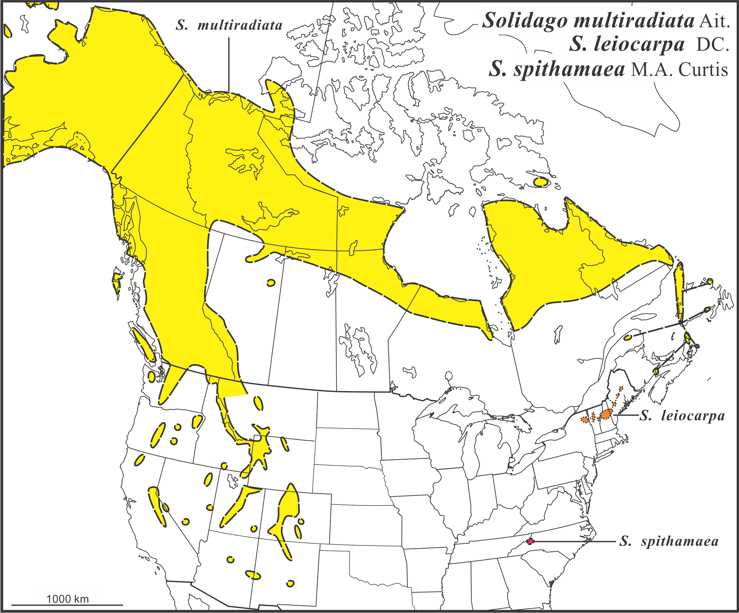Northern or Rocky Mountain Goldenrod
Solidago multiradiata Ait. is native to tundra and tundra-like habitats, alpine slopesand meadows across northern North America from Alaska to Newfoundland, at one gypsum outcrop location in Nova Scotia, and south in the Rocky Mountains to Arizona and New Mexico and in the Sierra Nevada Mts. in California. It also occurs in eastern Siberia. The species is distinguished by heads usually arranged in ± flat-topped or rounded inflorescences and its usually subequal, acute to acuminate phyllaries (Semple & Cook 2006 FNA). The species includes diploids (2n=18) and tetraploids (2n=36). Semple and Chmielewski (2022) reviewed all counts and published a cytogeography map for S. multiradiata, S. leiocarpa and S. spithamaea. Diploids of S. multiradiata occur throughout the range and are the only ploidy level known in southern portion of the range in the western mountains; tetraploids are common or dominant in the more northern portion of the range in the west.
Plants of S. multiradiata from the Rocky Mts. have been treated as var. scopulorum A. Gray; they differ little from plants of other parts of the range and recognition of the variety without further support does not appear justified (Semple & Cook 2006 FNA).

Semple, J.C., and J.G. Chmielewski. 2022. Cytogeography of Solidago sect. Multiradiatae (Asteraceae: Astereae). Ann. Missouri Bot. Gard. 107: 153–159.
Last revised 19 May 2025 by J.C. Semple
© 2025 J.C. Semple, including all photographs unless otherwise indicated.
1-6. Solidago multiradiata. 1. 1. Small plant, Semple & B. Semple 6576, Summit Co., Colorado. 2. Taller plant, Yellowstone NP, Wyoming. 3. Short shoot plant, Semple et al 9227, Summit Co., Utah. 4. Gypsum soil plant, Roberts & Pugh 65-584 UNB, Albert Co., New Brunswick. 5. Inflorescence, Chmielewski et al. CC4104, Alaska. 6. Heads, YNP, Colorado.











